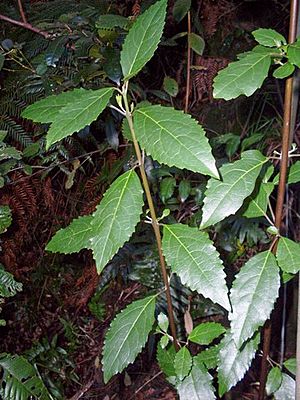Native mulberry facts for kids
Quick facts for kids Native mulberry |
|
|---|---|
 |
|
| Native Mulberry growing in a moist gully in the Blue Mountains National Park, Australia | |
| Scientific classification | |
| Genus: |
Hedycarya
|
| Species: |
angustifolia
|
The Hedycarya angustifolia, often called the native mulberry or Australian mulberry, is a cool plant found in the rainforests of southern and eastern Australia. It likes to grow in damp, cool valleys and moist forests, especially high up in the mountains. Sometimes, you might even spot it at the edge of sclerophyll forests, which are drier.
Contents
Where Does the Native Mulberry Grow?
This special tree grows naturally in a wide area. You can find it as far south as King Island in Bass Strait. From there, its home stretches across the Australian mainland. It grows through the state of Victoria, all the way up through New South Wales. Its northernmost point is the Conondale Range in the Sunshine Coast area of south-east Queensland.
What Does the Native Mulberry Look Like?
The native mulberry is usually a large shrub or a small tree. But sometimes, it can grow quite tall, reaching up to 20 meters (about 65 feet) high. Its trunk can also become quite thick, up to 40 centimeters (about 16 inches) wide. The trunk often has a crooked shape and might have more than one main stem growing from the ground.
Bark and Leaves
The bark of the tree is thin and feels smooth. It can be grey or a light brown color. You might notice some faint lines running up and down the trunk.
The leaves grow in an alternating pattern along the branches. They are shaped like an oval or a spear, with a pointy tip. Each leaf is usually between 8 and 20 centimeters (about 3 to 8 inches) long. The stem that connects the leaf to the branch is about 8 to 20 millimeters (about 0.3 to 0.8 inches) long. If you look closely, you'll see that the main vein (midrib) sticks out on the underside of the leaf, but it's a bit sunken on the top. All the leaf veins are easy to see.
Flowers and Fruit
The native mulberry produces greenish flowers. These flowers grow in clusters that look a bit like a raceme or a cyme. You can usually see these flowers between August and October.
After the flowers, the tree grows a fruit. This fruit is a yellow, fleshy drupe. A drupe is a type of fruit with a hard pit or "stone" inside, like a peach or a cherry. The native mulberry's fruit ripens from December to January.
How Was the Native Mulberry Used?
Long ago, the Indigenous Australians found many uses for the native mulberry tree. They would use the strong wood from the tree to make tips for their spears. They also used the wood to create bow drills. These tools were important for starting fires or drilling holes.
See also
 In Spanish: Morera Australiana para niños
In Spanish: Morera Australiana para niños

